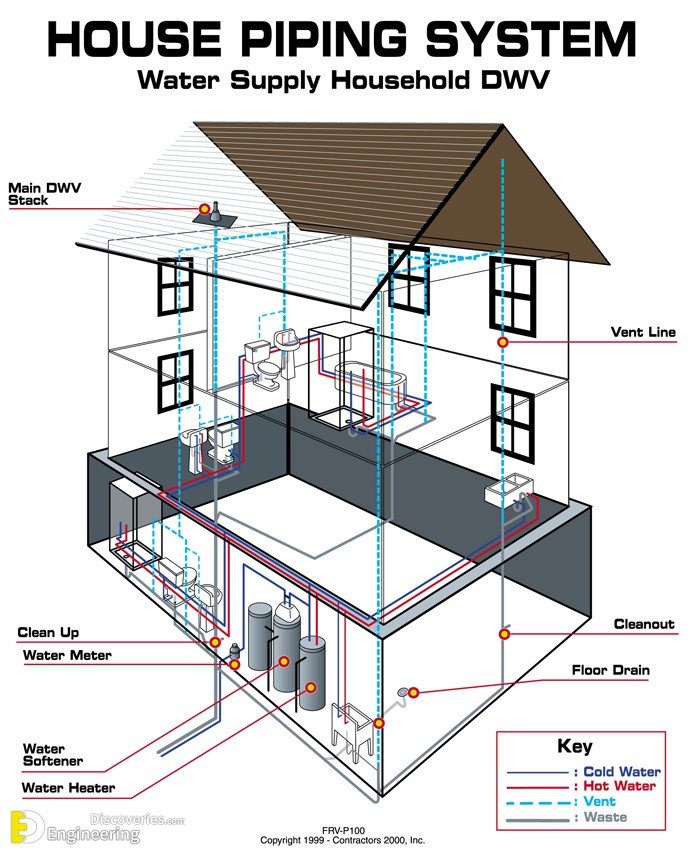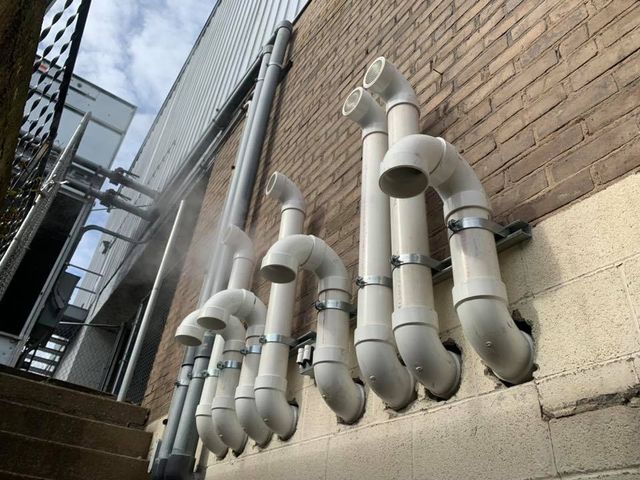The Key Components of Your Property's Plumbing System
The Key Components of Your Property's Plumbing System
Blog Article
Right here below you will find additional wonderful tips relating to Understanding Your Home's Plumbing Anatomy.

Comprehending exactly how your home's plumbing system works is essential for every house owner. From providing clean water for drinking, food preparation, and showering to safely removing wastewater, a well-maintained plumbing system is crucial for your family's health and wellness and comfort. In this comprehensive overview, we'll discover the detailed network that composes your home's pipes and offer suggestions on maintenance, upgrades, and managing typical concerns.
Intro
Your home's pipes system is more than just a network of pipelines; it's an intricate system that guarantees you have access to clean water and reliable wastewater elimination. Understanding its elements and how they interact can assist you prevent pricey fixings and make sure whatever runs efficiently.
Basic Parts of a Plumbing System
Pipelines and Tubing
At the heart of your plumbing system are the pipelines and tubes that bring water throughout your home. These can be made of various products such as copper, PVC, or PEX, each with its benefits in regards to durability and cost-effectiveness.
Components: Sinks, Toilets, Showers, etc.
Components like sinks, bathrooms, showers, and bathtubs are where water is utilized in your home. Comprehending how these components connect to the pipes system helps in diagnosing troubles and preparing upgrades.
Shutoffs and Shut-off Points
Shutoffs manage the circulation of water in your plumbing system. Shut-off shutoffs are essential throughout emergency situations or when you require to make repair services, allowing you to separate parts of the system without disrupting water circulation to the entire home.
Supply Of Water System
Key Water Line
The major water line connects your home to the local supply of water or a personal well. It's where water enters your home and is dispersed to various fixtures.
Water Meter and Stress Regulatory Authority
The water meter measures your water usage, while a stress regulatory authority ensures that water flows at a risk-free pressure throughout your home's plumbing system, protecting against damages to pipelines and fixtures.
Cold Water vs. Hot Water Lines
Recognizing the difference in between cold water lines, which supply water directly from the primary, and warm water lines, which lug heated water from the water heater, assists in troubleshooting and planning for upgrades.
Drain System
Drain Water Lines and Traps
Drain pipelines lug wastewater far from sinks, showers, and toilets to the sewer or sewage-disposal tank. Catches protect against sewage system gases from entering your home and also trap debris that might trigger blockages.
Air flow Pipelines
Air flow pipelines allow air into the drain system, stopping suction that might slow down water drainage and create catches to vacant. Correct air flow is essential for maintaining the integrity of your plumbing system.
Significance of Appropriate Drainage
Making sure proper water drainage stops backups and water damages. Consistently cleaning drains pipes and keeping catches can protect against pricey fixings and expand the life of your pipes system.
Water Heater
Types of Water Heaters
Hot water heater can be tankless or standard tank-style. Tankless heaters warmth water as needed, while storage tanks store warmed water for immediate usage.
Exactly How Water Heaters Connect to the Pipes System
Comprehending just how water heaters attach to both the cold water supply and hot water circulation lines helps in detecting problems like insufficient warm water or leaks.
Upkeep Tips for Water Heaters
Frequently flushing your hot water heater to remove sediment, inspecting the temperature level settings, and checking for leaks can expand its lifespan and boost energy performance.
Typical Plumbing Problems
Leakages and Their Causes
Leaks can take place as a result of aging pipelines, loose installations, or high water pressure. Addressing leaks without delay avoids water damages and mold development.
Clogs and Obstructions
Clogs in drains and bathrooms are typically brought on by flushing non-flushable items or a build-up of oil and hair. Utilizing drain screens and bearing in mind what decreases your drains pipes can stop blockages.
Signs of Plumbing Issues to Watch For
Low tide stress, slow-moving drains pipes, foul odors, or uncommonly high water bills are indicators of prospective plumbing troubles that must be dealt with promptly.
Pipes Upkeep Tips
Regular Examinations and Checks
Schedule annual plumbing examinations to capture issues early. Look for indicators of leaks, deterioration, or mineral accumulation in faucets and showerheads.
Do It Yourself Maintenance Tasks
Simple tasks like cleansing faucet aerators, looking for toilet leakages utilizing dye tablets, or shielding subjected pipes in chilly climates can protect against major pipes problems.
When to Call a Professional Plumbing Professional
Know when a plumbing concern needs specialist know-how. Attempting intricate fixings without appropriate expertise can cause even more damage and greater repair expenses.
Upgrading Your Plumbing System
Factors for Upgrading
Updating to water-efficient fixtures or changing old pipelines can improve water high quality, reduce water costs, and enhance the worth of your home.
Modern Plumbing Technologies and Their Advantages
Explore innovations like clever leak detectors, water-saving commodes, and energy-efficient water heaters that can save money and lower environmental effect.
Cost Considerations and ROI
Compute the in advance costs versus long-lasting financial savings when taking into consideration plumbing upgrades. Lots of upgrades pay for themselves via minimized utility expenses and fewer repair work.
Ecological Impact and Preservation
Water-Saving Fixtures and Devices
Mounting low-flow faucets, showerheads, and commodes can considerably lower water usage without compromising performance.
Tips for Minimizing Water Use
Straightforward habits like fixing leakages immediately, taking much shorter showers, and running full lots of laundry and dishes can save water and reduced your utility expenses.
Eco-Friendly Pipes Options
Think about lasting pipes materials like bamboo for flooring, which is durable and eco-friendly, or recycled glass for counter tops.
Emergency Readiness
Steps to Take During a Plumbing Emergency
Know where your shut-off valves are located and how to turn off the supply of water in case of a burst pipe or major leak.
Importance of Having Emergency Contacts Useful
Keep get in touch with info for regional plumbing technicians or emergency situation solutions readily available for quick reaction during a plumbing crisis.
DIY Emergency Fixes (When Applicable).
Temporary fixes like using duct tape to patch a dripping pipeline or positioning a pail under a trickling faucet can minimize damage till a specialist plumbing professional gets here.
Verdict.
Understanding the anatomy of your home's plumbing system encourages you to keep it successfully, saving time and money on repairs. By adhering to normal maintenance regimens and remaining notified about modern pipes innovations, you can guarantee your pipes system operates successfully for many years to come.
Understanding Your Home Plumbing System: A Comprehensive Guide
Plumbing System: The Lifeline of Your Home
At its core, the plumbing system is designed to perform two primary functions: bring fresh water into your home and remove wastewater. The system is a network of pipes, fixtures, and other components that transport water and sewage. Residential plumbing systems include potable water supply lines, drain-waste-vent (DWV) systems, and various plumbing fixtures that make water use in daily tasks possible.
Key Components:
Water Supply: This part of your plumbing system brings municipal water into your home, passing through the main water supply line. It s responsible for supplying all water needs, from drinking to bathing.
Drainage System: It carries waste and water away from your home to the sewer or septic system. This system includes all the piping within your home that leads to external sewage or septic systems.
Vent System: An essential yet often overlooked component, the vent system allows sewer gases to escape and lets air into the drainpipes, ensuring water and waste move correctly through the system.
Fixture: More Than Just Taps and Toilets
Plumbing fixtures are the most interactive parts of the plumbing system, including faucets, showers, toilets, and sinks. Each fixture is connected to the plumbing system and plays a role in either the delivery of freshwater or the disposal of waste and wastewater.
Types of Fixtures:
Faucets and Sinks: Used for washing hands, dishes, and other daily water needs.
Toilets: Dispose of human waste through the sewage system.
Bathtubs and Showers: Provide bathing facilities, requiring both hot and cold water supply.
Water Supply: The Source of Life
The water supply system is a critical component, ensuring that potable water is available throughout your home for various uses, including drinking, cooking, and cleaning. This system consists of pipes that distribute water to different parts of the house, controlled by valves to regulate the water flow.
Types of Plumbing: Materials and Methods
Various types of plumbing systems and materials are used in residential settings, each with its advantages and applications. From copper and PVC pipes for water supply to cast iron and ABS for drainage, the choice of materials can impact the longevity and efficiency of your plumbing system.
https://intownplumbingtx.com/articles/home-plumbing-system-guide/

Understanding Your Home Plumbing System: A Comprehensive Guide
Plumbing System: The Lifeline of Your Home
At its core, the plumbing system is designed to perform two primary functions: bring fresh water into your home and remove wastewater. The system is a network of pipes, fixtures, and other components that transport water and sewage. Residential plumbing systems include potable water supply lines, drain-waste-vent (DWV) systems, and various plumbing fixtures that make water use in daily tasks possible.
Key Components:
Water Supply: This part of your plumbing system brings municipal water into your home, passing through the main water supply line. It s responsible for supplying all water needs, from drinking to bathing.
Drainage System: It carries waste and water away from your home to the sewer or septic system. This system includes all the piping within your home that leads to external sewage or septic systems.
Vent System: An essential yet often overlooked component, the vent system allows sewer gases to escape and lets air into the drainpipes, ensuring water and waste move correctly through the system.
Fixture: More Than Just Taps and Toilets
Plumbing fixtures are the most interactive parts of the plumbing system, including faucets, showers, toilets, and sinks. Each fixture is connected to the plumbing system and plays a role in either the delivery of freshwater or the disposal of waste and wastewater.
Types of Fixtures:
Water Supply: The Source of Life
The water supply system is a critical component, ensuring that potable water is available throughout your home for various uses, including drinking, cooking, and cleaning. This system consists of pipes that distribute water to different parts of the house, controlled by valves to regulate the water flow.
Types of Plumbing: Materials and Methods
Various types of plumbing systems and materials are used in residential settings, each with its advantages and applications. From copper and PVC pipes for water supply to cast iron and ABS for drainage, the choice of materials can impact the longevity and efficiency of your plumbing system.
https://intownplumbingtx.com/articles/home-plumbing-system-guide/
We were shown that write-up on Anatomy of a House: Understanding the Components from an associate on a different blog. Appreciated our piece of writing? Please quickly share it. Help another person discover it. Thanks for your time. Please come visit our blog back soon.
Schedule Report this page